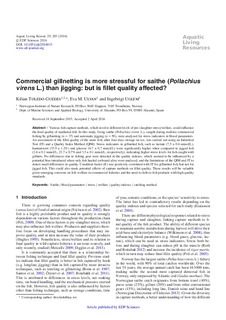Commercial gillnetting is more stressful for saithe (Pollachius virens L.) than jigging: but is fillet quality affected?
Journal article, Peer reviewed
Date
2016Metadata
Show full item recordCollections
- Publikasjoner fra CRIStin - NINA [2364]
- Scientific publications [1392]
Original version
10.1051/alr/2016013Abstract
Various fish capture methods, which involve different levels of pre-slaughter stress/welfare, could influence
the final quality of marketed fish. In this study, living saithe (Pollachius virens L.), caught during realistic commercial
fishing by gillnetting (n = 37) and automatic jigging (n = 50), were analysed for stress indicators in blood parameters.
An assessment of the fillet quality of the same fish, after four days storage on ice, was carried out using an Industrial
Test (IT) and a Quality Index Method (QIM). Stress indicators in gillnetted fish, such as lactate (7.5 ± 0.6 mmol/L),
haematocrit (33.9 ± 1.2%) and glucose (6.7 ± 0.7 mmol/L) were significantly higher when compared to jigged fish
(2.6 ± 0.2 mmol/L, 23.7 ± 0.7% and 3.3 ± 0.1 mmol/L, respectively), indicating higher stress levels for fish caught with
gillnets. No differences due to fishing gear were detected in the quality indexes, which seemed to be influenced by a
potential bias introduced when only fish hauled on board alive were analysed, and the limitations of the QIM and IT to
detect small differences in quality. Condition factor (K) was positively correlated with IT for gillnetted fish, but not for
jigged fish. This could also mask potential effects of capture methods on fillet quality. These results will be valuable
given emerging concerns on fish welfare in commercial fisheries and the need to deliver fish products with high quality
standards.
